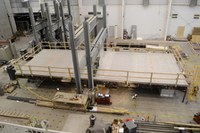Laboratory Testing of Railroad Flatcars For Use as Highway Bridges on Low-Volume Roads to Determine Ultimate Strength and Redundancy
Several counties in Indiana use retired railroad flatcars for a bridge superstructure to replace existing deteriorating county bridges. There are over 130 railroad flatcar bridges in the state of Indiana. The main objective of this laboratory project is to provide greater confidence to county engineers when load rating these bridges by studying the ultimate strength and load redundancy of the bridge system. Testing in the laboratory creates the opportunities to test at larger loads, use a greater number of instrumentation, and simulate a controlled fracture test.
Unique Aspects
- First full-scale laboratory test of side-by-side RRFCs in the world. This was made possible because of the capacities of Bowen Laboratory.
- First full-scale after-fracture redundancy tests of RRFCs.
- First full-scale testing of RRFCs with concrete composite deck.
ABSTRACT
Railroad flatcars (RRFCs) are a convenient option to replace existing deteriorating bridge structures on low-volume roads in rural communities. However, RRFC’s are not addressed in the existing AASHTO Bridge Rating specifications and engineers have no guidance as to how to calculate a safe load rating. There are over 100 of these bridges in Indiana alone and thousands throughout the United States, mostly in rural areas. Further, these bridges are often labeled as “Fracture Critical” (FC) meaning that if one of the main girders were to fail, the bridge would collapse. However, the RRFCs were designed for railroad loads, which are much higher than typical highway loading and hence are believed to have sufficient capacity even if one component failed. If it could be shown that these bridges should not be classified as FC, expensive biennial inspections would not be required and routine inspection was sufficient.
Laboratory testing of a RRFC bridge at Bowen Laboratory allowed for a controlled setting to fracture the main girders and load the bridge system after fracture occurred to determine the new load path. The laboratory bridge was constructed with a concrete deck that was made composite with the main girders and exterior girders. To produce a brittle fracture, the members were notched, cooled with liquid nitrogen to sub -100F temperatures, and then point loaded at the notched location. The second fracture test simulated a worst case scenario, although highly unlikely, with both main girders fractured. The bridge displayed adequate redundancy and was able to sustain a point load of 190 kips at the fracture location with both main girders fractured. The resulting evaluation procedures are being considered for in inclusion in the AASHTO Manual for Bridge Evaluation.
The final report can be found here:
http://docs.lib.purdue.edu/inltaptechs/5/
The following links provide video footage of both fracture tests:
http://www.youtube.com/watch?v=krxCZ-UDZ5I (Fracture Test 1)
http://www.youtube.com/watch?v=yEqaMXOvUV8 (Fracture Test 2)
http://www.youtube.com/watch?v=RumXqSG-HC4 (Concrete Deck Placement – time lapse)

